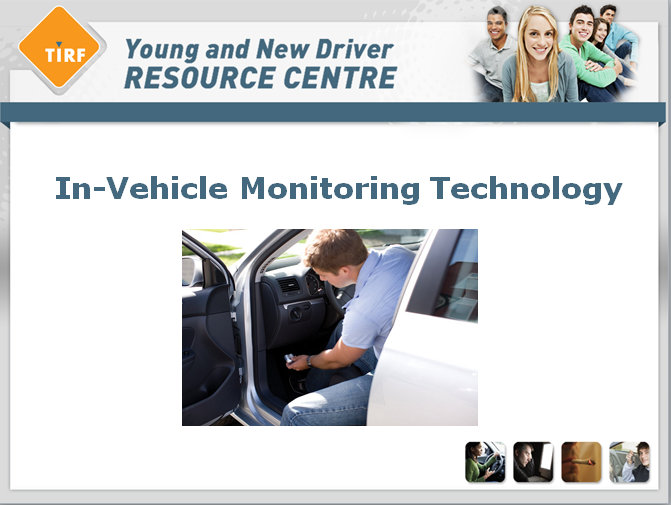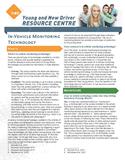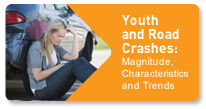The Issues - In-Vehicle Monitoring
| Video coming soon
Program:
Agency: |
Downloads

PowerPoint

Factsheet |
DEFINITION
What is in-vehicle monitoring technology?
How common is in-vehicle monitoring technology?
BEHAVIOURS
Does in-vehicle technology reduce the risky driving behaviour of young drivers?
Is in-vehicle monitoring technology otherwise beneficial for young drivers?
ATTITUDES, CONCERNS AND PERCEPTIONS
What do parents think about in-vehicle monitoring technology?
What do teens think about in-vehicle monitoring technology?
SOLUTIONS
How would in-vehicle technology affect Graduated Driver Licencing (GDL) programs?
What else can parents do help reduce crash risk of young drivers?
What initiatives are available that support or administer in-vehicle technology?
REFERENCES
DEFINITION
What is in-vehicle monitoring technology?
There are several types of technologies available to monitor, record, influence and provide feedback regarding the in-vehicle behaviour and environment of young drivers. Technologies can provide this information in three different ways:
- Forcing. This system teaches the driver safe behaviour through habit and blocking unsafe bevahiour. E.g., the driver cannot turn on the vehicle until their seatbelt is fastened.
- Feedback. This system provides a cue if a driver is driving in a hazardous manner. E.g., if the vehicle is travelling faster than the posted speed limit, a sensor will alert the driver with either a flashing light or a noise.
- Reporting. This system uses a device in the vehicle to record driver performance and contextual information for parents and the young driver1 and provides feedback. E.g., a GPS recognizes the vehicle’s location, accelerometers gauge how quickly the driver is accelerating, and radar sensors measure sharp turns or abrupt braking. In more extreme cases, there are cameras that switch on any time they are triggered by a relevant event (e.g., speeding, abrupt braking) to record what is occurring inside the vehicle at that time (e.g., driver is on the phone or talking with passengers).2
In-vehicle monitoring technologies installed in the vehicles of young drivers are designed to prevent risky behaviours, either by restricting speeds, locking out certain functions (such as the radio) or deterring risky behaviour by triggering a report to be sent to parents if a driving violation is committed.3 These technologies can help protect young drivers who have the highest crash risk of all driver age groups. To illustrate, when sober, 16-19 year olds have a fatal crash rate more than four times as high as that of drivers aged 25-34, and nine times as high as drivers aged 45-54.4 Only a certain amount of risk can be prevented through driver education and awareness programs for young drivers. The use of monitoring devices can provide an extra layer of protection for the young driver.
How common is in-vehicle monitoring technology?
Up to this point, in-vehicle monitoring technology has been used primarily by researchers for study purposes, and has yet to become popular in the general population. Not surprisingly, a survey conducted of parents of young new drivers in the United States (U.S.) found that only half of these parents were aware of in-vehicle monitoring technology.5 Currently, parents are using more traditional means to manage their teens such as imposing rules, setting curfews, and restricting vehicle access. At this time, in-vehicle monitoring technology is costly and requires technical knowledge to install and use. Until these barriers have been overcome, parents will likely continue to rely upon known methods of parental authority in order to set driving boundaries for their young drivers. Once the benefits of the technology become well known, it may become a popular driver education tool.
1 Brovold et al. 2007
2 Musicant and Lampel 2010
3 Musicant and Lampel 2010
4 Mayhew et al. 2005
5 McCartt et al. 2007
Back to Top
BEHAVIOURS
Does in-vehicle technology reduce the risky driving behaviour of young drivers?
Yes. A study was conducted where an “intervention” (e.g., a blinking light on the camera installed in the vehicle flashing in response to any driver error, or a weekly printed safety report based on the data collected from the device monitoring driving behaviour) occurred whenever a “safety-relevant event” was detected. A “safety-relevant event” was an unsafe driving maneuver such as speeding, turning a corner too sharply or following too close. These interventions significantly decreased the number of safety-relevant events among young drivers; there was a 76% reduction in these events after the use of interventions compared to the beginning of the study. There was a five-fold decrease in events where drivers were turning a 90 degree corner too fast. This is important because 22% of all fatalities involve a single vehicle at an intersection (which has 90-degree corners).6 Another study found that in-vehicle alerts improved seatbelt use for young drivers and decreased speeding slightly while the device was installed. Unfortunately speeding increased again after the study was completed.7
Is in-vehicle monitoring technology otherwise beneficial for young drivers?
Yes. Individuals want and seek feedback about their performance; it helps them learn about themselves. Feedback has been proven to consistently improve performance and safety and it is essential for learning and motivation. Once drivers are aware they are being observed they are likely to modify their behaviour in positive ways (e.g., a young driver is less likely to speed if they know their mother or father will find out about it).8
By providing constructive feedback from a non-biased source which is able to capture teachable in-vehicle moments, such as video camera clips and statistical reports of driver behaviour, in-vehicle monitoring creates an opportunity for young drivers to learn from their errors and can open up dialogue between parents and teens about safe driving.9 With the insight provided by feedback from these devices, parents are better able to influence the learning experience of their young driver by targeting the key areas highlighted by the monitoring system. Objective feedback combined with the expertise of an experienced driver can create a balanced learning environment for the teen.10
6 McGehee et al. 2007
7 Farmer et al. 2010
8 Huang et al. 2005
9 McGehee et al. 2007
10 Brovold et al. 2007
Back to Top
ATTITUDES, CONCERNS AND PERCEPTIONS
What do parents think about in-vehicle monitoring technology?
A study conducted in the U.S. surveyed the parents of young new drivers in Minnesota, North Carolina, and Rhode Island. All parents surveyed planned to monitor their teenage driver after licensure. When asked how, many answered they would frequently ride with teens, control which trips were permitted, limit passengers, and set curfews. Only 1% responded they would use in-vehicle technology to monitor the young drivers. This is surprising because over half of the respondents wanted to know if their teens were speeding, driving while using a cell phone, or had too many passengers – behaviours which could be detected by in-vehicle devices. That being said, only half of the parents had heard of supervising devices, illustrating how this technology is not well known enough to be considered a viable tool for controlling teen driving. When asked why parents would not use these devices in their teen’s vehicle, a majority responded that they trusted their teens, and that this would be an invasion of privacy.11
What do teens think about in-vehicle monitoring technology?
Although there is little research on teen driver opinions about in-vehicle monitoring technology, there is research focusing on teens and privacy, and the opinions of commercial drivers about monitoring technology. Commercial truck drivers were asked how they would feel about their driving behaviour being recorded and monitored on the job, and receiving subsequent feedback. Drivers responded that they would feel mistrusted by their employer and it would be an invasion of their privacy.12 Invasion of privacy seems to be the main issue with respect to in-vehicle monitoring. Parents should be conscious of how this perceived invasion may affect young drivers. Privacy is an important part of development, crucial for the independence and identity of young drivers. If parents limit the privacy afforded to teen drivers, it might have the opposite effect, and enhance their risk-taking behaviour. If privacy is limited, teens may take advantage of any little amount they receive, and create as much excitement for themselves in these moments as possible. Although in-vehicle monitoring has its benefits, parents must be conscious of respecting the importance of the privacy of their teens and fostering a relationship of trust.13
11 McCartt et al. 2007
12 Huang et al. 2005
13 Foltz 2011
Back to Top
SOLUTIONS
How would in-vehicle technology affect Graduated Driver Licencing (GDL) programs?
In-vehicle monitoring technology could complement GDL programs already in place. During a driver’s primary unsupervised period, a video recording device could act as a form of supervision. If teens are aware that parents have access to the feedback provided by the sensors, they are more likely to drive within safe restrictions. The use of this technology to condition teen driving behaviour can help them create and improve safe driving habits that they will have for life.14 In-vehicle monitoring allows parents to gauge whether their young drivers are abiding by the Graduate Driver Licensing (GDL) program restrictions in their particular stage of the program (e.g., number of passengers, road types restricting speed). A pair of ‘eyes’ in the vehicle to document whether or not drivers comply with the rules of their GDL stage can help programs have farther reaching effects than without the technology.
What else can parents do help reduce crash risk of young drivers?
Since in-vehicle monitoring technology has not become a mainstream option for the parents of young drivers, parents should still consider other means for keeping their kids safe. An important way to help reduce a driver’s crash risk is through the type of vehicle they can drive. Vehicle choice for young drivers can substantially affect the likelihood of injury in a crash.15 Each vehicle has a unique safety rating and death risk in the event of a crash. If parents are planning on purchasing a vehicle for their young driver they should take these vehicle safety ratings into consideration. Teens often drive older vehicles, smaller in size, and these vehicles generally have inferior crash protection. The death rate per registered vehicles is twice as high for small cars as large cars. Thus, if parents are buying a vehicle for a young driver, greater emphasis should be placed on size and safety features, although, understandably, cost is an issue. If cost is preventing parents or their teen from buying a safe vehicle then delaying vehicle ownership for teens may be the safer option.16
What initiatives are available that support or administer in-vehicle technology?
American Family Insurance includes in its Family Auto Policy the Teen Safe Driver Program. Customers with the Family Auto Policy can have an in-vehicle monitoring device installed in a young driver’s vehicle once they have acquired their full licence and no longer have a supervisor accompanying them, free of charge. The device detects any sights and sounds related to erratic movement and if an incident occurs (e.g., extreme braking, cornering or accelerating too quickly, crashes) the camera records the first eight seconds before the incident and the four seconds afterwards.
This information is transmitted wirelessly to the Teen Safe Driver Center and it is reviewed and objectively evaluated by a trained driving coach. Each week the parents of teen drivers receive a report card detailing the teen’s performance and they also have access to footage of any incidents. This allows parents to start a conversation with their teen about their driving behaviour and to discuss their strengths and weaknesses on the road and safe driving habits.
According to a 2011 study by the University of Maryland’s National Study Center for Trauma and EMS the program has been found to reduce risky driving habits by more than 70% for the young driver, with a 50% decrease experienced immediately. This rate is maintained throughout the program. Although at first teens were apprehensive of the technology, the program’s benefits were soon discovered:
- The camera could prove that teens were not (or were) responsible for a traffic incident.
- The technology gave teens an ‘out’ for peer pressure. Teen passengers understood that their behaviour was being recorded and thus they needed to abide by the rules of the vehicle (e.g., passenger restrictions, volume of music).
- Once the young driver had several positive report cards, parents began to trust their teens behind the wheel and gave them more driving freedoms.17
Esurance, a unit of Allstate, has a similar program in 39 states but with an added bonus of the choice for parents to create a customized block list that can stop specific cell phone activities when the car is in motion. Esurance’s DriveSafe program includes an application which is installed on a teen’s smart phone which limits the use of text, email, apps, and phone calls while they are driving (with the exception of 911). Parents can also log on to the website and view how often their teen is driving, if there is any dangerous driving behaviours (e.g., hard braking), and how well they are doing in comparison to other novice drivers.18
Similarly, the Canadian insurance company Industrial Alliance has a car insurance program called “Mobiliz” in which the customer can install a monitoring device into their vehicle and have their driving regularly monitored. The device tracks the driver’s acceleration, number of kilometers driven, nighttime speeding, sharp braking, and speeding over the speed limit. From their driving behaviour record, the customer is ranked as exceptional, safe, normal, unsafe or dangerous, and their premium is based on this ranking. This means that there could be a discount or an increase in their premium each month, depending on their driving behaviour. The program, which was originally developed for teens, is also available to drivers who are 25 and older.
Car manufacturers are also beginning to take advantage of in-vehicle monitoring technologies. Vehicle manufacturer Ford has offered the My Key feature in its vehicles since 2010.19 This system allows parents to preset certain controls in their vehicles for teen drivers. For instance, My Key can automatically set limits on speed (to 135 km/hr) and mute the audio system volume until the safety belts are buckled.
Additionally, this system gives extra warnings to young drivers who may not be familiar with certain vehicle features yet. One example of this is an extended warning period for low fuel (e.g., 100 km to empty instead of 30 km), allowing more time for young drivers to safely pull over for gas.
14 McGehee et al. 2007
15 Williams et al. 2006
16 IIHS 2004
17 American Family Insurance 2012
18 GHSA 2014
19 Ford Motor Company 2013
Back to Top
REFERENCES
American Family Insurance. (2012). Teen Safe Driver Program. Retrieved from: http://www .amfam.com/microsites/teen-safe-driver/default.asp.
Brovold, S., Ward, N., Donath, M., Simon, S., Shankwitz, C., Creaser, J. (2007). The use of technology to address patterns of risk among teenage drivers. Journal of Safety Research. 38(4), 413-422.
Farmer, C.M., Kirley, B.B., McCartt, A.T. (2010). Effects of in-vehicle monitoring on the driving behavior of teenagers. 41, 39-45.
Foltz, R. (2011). Parental Monitoring or an Invasion of Privacy. Reclaiming Children and Youth. 20(3), 41-42.
Ford Motor Company. (2013). My Key. Retrieved from: http://www.ford.ca/technology/?polaroid=p17&searchid=google|yBKLwjxR.
Governors Highway Safety Association (GHSA). (2014). GHSA Directions in Highway Safety. January 2014 Issue. Washington, D.C.
Huang, Y.H., Roetting, M., McDevitt, J.R., Melton, D., Courtney, T.K. (2005). In-Vehicle Safety Feedback. Professional Safety. 50(1), 20-27.
Insurance Institute for Highway Safety (IIHS). (2004). Status Report: Many risky beginners aren’t driving the most crashworthy vehicles. 39(8), 1-8.
Mayhew, D.R., Simpson, H.M., & Singhal, D. (2005). Best Practices for Graduated Licensing in Canada. Ottawa, Ontario: Traffic Injury Research Foundation.
McCartt, A.T., Hellinga, L.A., Haire E.R. (2007). Age of licensure and monitoring teenager’s driving: Survey of parents of novice teenage drivers. Journal of Safety Research. 38(6), 697-706.
McGehee, D.V., Raby, M., Carney, C., Lee, J.D., Reyes, M.L. (2007). Extending parental monitoring using an event-triggered video intervention in rural teen drivers. Journal of Safety Research. 38, 215-227.
Musicant, O., Lampel, L. (2010). When Technology Tells Novice Drivers How to Drive. Journal of Transportation Research Board. 2182(1), 8-15.
Williams, A.F., Leaf, W.A., Simons-Morton, B.G., Hartos, J.L. (2006). Vehicles Driven by Teenagers in Their First Year of Licensure. Traffic Injury Prevention. 7(1), 23-30.
Back to Top
Last updated February 2014





